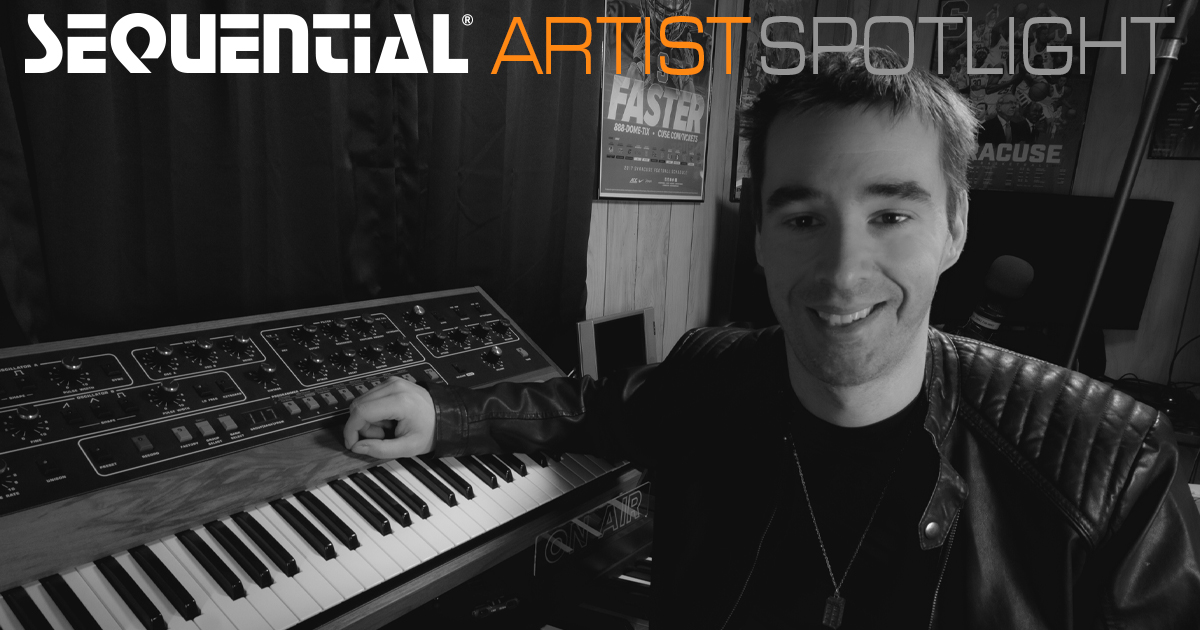
Cory Carlick is the CEO and Chief Creative Officer of SKYCRON and produces weekly television series and livestream broadcasts for clients including FOX, ABC, CBS, NBC and CW stations across the United States. He is also a film and television composer, currently scoring and producing the U.S. Weekly syndicated television series, GO/NITRO, which has a weekly reach of approximately 26 million viewers. He has directed numerous TV ad campaigns and filmed productions with a long list of brands including Michelin, Pylon, Baskin Robbins, and many others.
We chatted with Cory on how he uses the Prophet-5 in his music:
What made you choose the Prophet-5?
Truthfully, I had wanted one since I was about 11 years old. I was listening to my dad’s Rick Wakeman albums. At that point, it was mainly visual, which is the kind of crap that grabs you sometimes when you’re a kid. It was a beautiful instrument, with the wood paneling. It was, and is, a pretty classically sexy looking piece of kit. I had an idea of what it sounded like, leads and whatnot. Rick is a hell of a keyboardist, so his hands fly around a lot. For that reason, though, patches don’t tend to linger much for you to be able to hear them for long, because the style means you’re switching through sounds a lot as he does. He has a kinetic playing style as a result of his classical training, and the sounds are there to serve that technique, as it should be for his style. Somewhat on the flipside, I was also heavily into a lot of the more lush musicals of Andrew Lloyd Webber, before he was a Lord or even a Sir. It was kind of weird for a kid to be into, and I suppose much less notice, that kind of orchestration. But even at the time, they stood out to me as they had a haunting, cinematic quality that could not be achieved by an orchestra alone. So, what was it?
I had acquired the original cast album of Cats and was drawn to a lot of the interesting sounds. An organ that wasn’t quite an organ, you know? But more than that. Haunting pads, leads and drones. I had no idea what in the hell was making those sounds, but I knew it wasn’t an orchestra. In the liner notes, rather than the usual orchestral credit of ‘Keyboardist/Pianist”, it actually said Prophet-5. That was when I really made the connection. Later, as I started to work in television, I made more of a connection to its warm, ethereal quality. My good friend Jon Stroll, with whom I still work, was an award-winning composer in his own right. He used the Prophet-5 extensively on “The Raccoons”, an animated series from the 1980s that had an outstanding score, and I recognized that pure quality. The other thing about the Prophet-5 that really stands out for me. I had wanted this instrument for over twenty years, and had owned many classic synths – but I could never get my hands on my own Prophet-5; I had to sponge off of other people’s Rev 2s and 3s. Now, thanks to Sequential, I finally have my own, and I love it.
How are you using it?
Right now, I’ve been using the Prophet-5 at SKYCRON to score Season 4 of GO/NITRO, a nationally syndicated sports show that runs across the United States on FOX, ABC, CBS, NBC and CW stations. The show has a lot of music in it, so I use it for bouncy basslines that are warm and fat, but still retain the haunting bell-like clarity that I find is a hallmark of its sound. The other thing I use it a lot for is more emotional pad work. It also, much like Mr. Webber does, can frame an orchestra very nicely with its tones. I also regularly do livestreams with it on Skycron’s YouTube channel. I also use it for sound design, as well as scoring on various other shows and commercials that we produce here at SKYCRON.
What’s one of your favorite things about it?
It’s really the tone. It’s clean, but not clinical. It’s warm, and fat without being dirty…and a little sinister if you want it to be. It’s beautiful sounding, but can also have that “smiling in the dark” tone on top of it. It’s hard to explain, but you know it when you hear it. It has a pure quality, particularly when you have a warm sawtooth with a gentle attack on Osc 1. Then you mix a second sawtooth on Osc 2, and detune just a hair. The lows are silky, but have a dark thunder to them. When you have an orchestra and you want to add a dark bit of bass you can feel but not hear, the Prophet 5 is the only synthesizer for me that can do that in such a way that my hair stands on end. It also sits nicely in a mix, but can absolutely command attention if you let it take center stage.
Any interesting Prophet-5 tricks or techniques you’d like to share?
You know, the Prophet-5 is so intuitive and has such a history, I’m not sure what I can add that hasn’t already been handled so brilliantly by so many amazing artists.
LINKS
MORE ABOUT SEQUENTIAL
For more information, check out the Sequential product page here.
Find your local dealer for pricing here.
